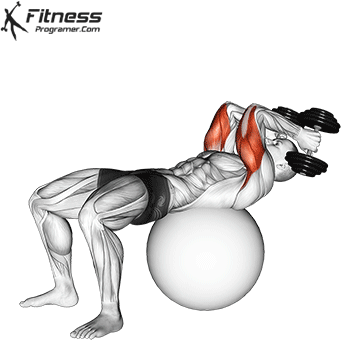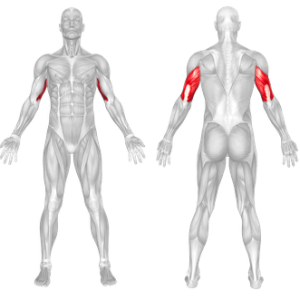Overview
This variation of the traditional triceps extension is performed while lying on an exercise ball, rather than a bench or floor. The instability of the ball forces the core, glutes, and stabilizer muscles to work harder to maintain proper positioning, making it a more challenging and functional exercise.
It is commonly used in functional fitness, strength training, and rehabilitation programs to develop arm definition, core strength, and joint stability.
How to Perform the Exercise Ball Triceps Extension

Step 1: Setup and Positioning
Select a pair of dumbbells with a manageable weight.
Sit on an exercise ball and walk your feet forward until your upper back and shoulders are supported on the ball.
Engage your core and glutes to maintain stability.
Hold a dumbbell in each hand and extend your arms straight above your chest.
Step 2: Execution
Lower the dumbbells by bending your elbows, keeping them close to your head.
Bring the weights down behind your head in a controlled motion.
Engage your triceps and extend your arms back to the starting position.
Repeat for the desired reps, keeping your core tight for balance.
Tips for Proper Form
Keep your elbows stationary to ensure triceps activation.
Move slowly and with control to maintain stability on the ball.
Engage your core and glutes to prevent excessive movement.
Choose an appropriate weight that allows full range of motion without losing form.
Breathe properly, exhaling as you extend your arms and inhaling as you lower the weight.
Common Mistakes to Avoid
Letting the elbows flare out, which reduces triceps engagement.
Using momentum instead of controlled movement.
Arching the back, which can cause strain and instability.
Holding the weights too far forward, limiting the range of motion.
Not engaging the core, leading to poor balance and potential injury.
Benefits of the Exercise Ball Triceps Extension
Strengthens the Triceps: Builds upper-arm strength and definition for improved pushing movements.
Improves Core Stability: The unstable surface forces the core to engage, enhancing balance and coordination.
Enhances Functional Strength: Develops joint stability and muscle control, translating to better athletic performance.
Reduces Wrist and Shoulder Strain: Compared to barbell-based triceps exercises, this variation allows for a more natural movement pattern, reducing joint stress.
Increases Flexibility and Mobility: Encourages full range of motion, improving shoulder and elbow mobility.
Muscles Worked

